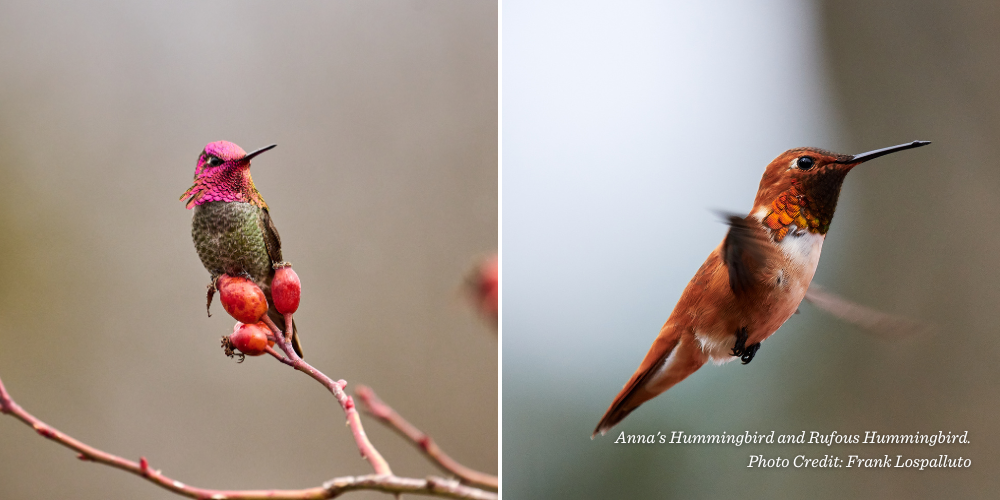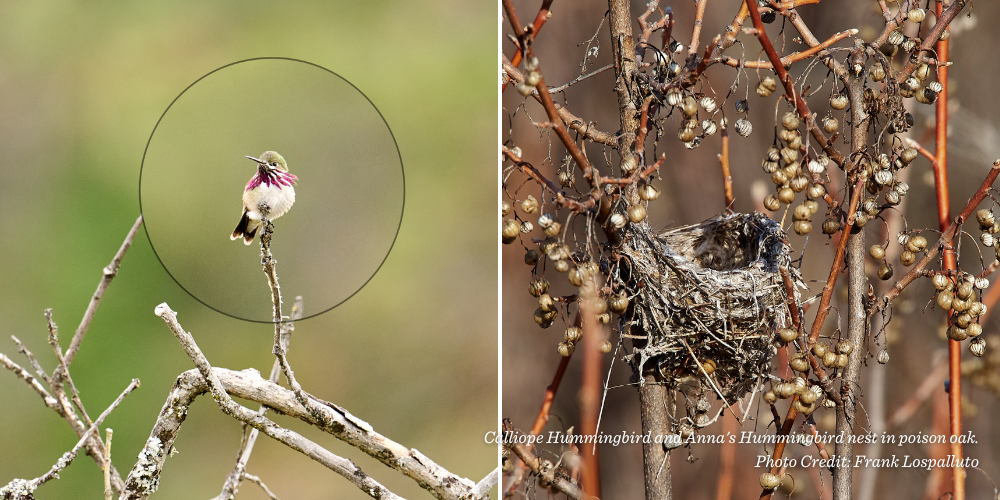Fierce Iridescent Sprites
Stand on the Grizzly Peak Trail near Ashland in the north-facing wet meadows during August and listen to the buzz, not the buzz of bumble bees, but of wing-whirring hummingbirds nectaring on towering larkspurs and monkshood. The male hummers may also buzz past, defending their flowery territories from intruders, and if you are lucky, one may hover a few feet from your face, staring you down. Pugnacious and brave, glittering sprites.
Hummingbirds only live in the Americas, prefer to visit red to orange tubular flowers (colors bees can’t see), and build tiny nests made of spider webs, shield lichens, and botanical downy fluff. Their hearts beat 1200 times per minute to spark their zippity lives, thrumming wings, and ferocious spirits. While hovering, hummers drink flower nectar, often deeply inserting their heads into flowers to reach the sugar water found in long petal spurs. Diminutive birds with dazzling rainbow-colored feathers, hummingbirds have long inspired love, myths, and admiration. In Jackson and Josephine Counties, you are likely to meet three species.
Anna's Hummingbird
These locally resident birds often visit hummingbird feeders or tree wells left by sapsuckers during the winter, tongue-flicking tree sap infused with insect protein. Before the 1930s, they bred in Baja Mexico but have been moving north with changing climate, extending their range to Vancouver, Canada. During courtship displays, the males fly up to 130 feet high into the sky, then plunge to earth braking at the last minute with a tail flare and chirpy squeak. The sound originates from the tail feathers and males have been clocked going 385 body lengths per second, faster than a Peregrine Falcon, and experience more G-acceleration than a fighter jet pilot.
ID tip: Look for an iridescent pink-red head and throat on males, a straight beak, and a comparatively stocky build, for a hummingbird.
Rufous Hummingbirds
When the first pink urn-shaped whiteleaf manzanita flowers begin to bloom in early spring, Rufous Hummingbirds appear in our region. They overwinter in Mexico in the mountains, and some migrate all the way to Alaska to breed. By body size (3 inches), Rufous have the longest migration of any bird in the world and are so feisty, they can even chase away chipmunks. Their population has declined 67% from 1966-2019 due to habitat loss and climate change; the use of neonicotinoid pesticides has also been implicated in their decline.
ID tip: Males have fiery red throats, or gorgets, orange backs and bellies, and the wings don’t reach the tail tip when perched. Similar, Allen’s Hummingbirds are coastal, and the males generally have bronze-green backs.
Calliope Hummingbird
The smallest bird of the United States, the weight of a ping pong ball, these lively wee birds breed in the mountain meadows of the Northwest and spend winters in the pine-oak forests of Mexico. They travel around 5,000-miles up the Pacific Coast and then south along the Rockies. These impressive travelers are named after Calliope, one of the nine Greek muses and patron of epic poetry. They are found in mixed conifer/hardwood forests and sometimes in the riparian corridor and near flower meadows. Around here, look for them in in manzanita and buckbrush patches or openings with flowering currants. They are often overlooked because of their quiet nature.
ID tip: Males have magenta rays or spangles on the throat and a greenish vest, a hunched posture, and a diagnostic zinging sound during U-shaped flight displays.














